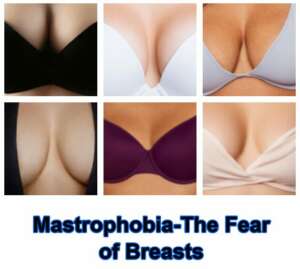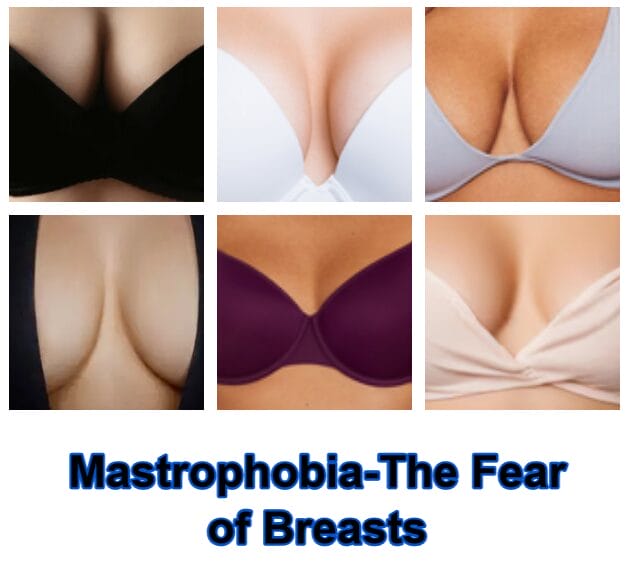Share This Article
Mastrophobia – Understanding the Fear of Breasts
The concept of fearing breasts may seem strange in a country when the media and culture frequently accentuate them. But for some, this anxiety is a real, upsetting reality known as mastrophobia. This phobia is characterized by an extreme fear of breasts, which can seriously affect daily comfort and interpersonal connections. Let’s examine what mastrophobia is, how it appears, what symptoms it causes, and what kinds of treatments are accessible.
What Is Mastrophobia?
Definition: Mastrophobia is an irrational and excessive fear of breasts, human breasts. It is a specific phobia that can affect both men and women, although it is considered a rare phobia.
Impact: The phobia can complicate personal relationships, social interactions, and even activities like going to the beach or watching movies. The impact can be as strange as the phobia itself.

How Someone May Develop Mastrophobia
Cultural Influences: In some cultures, breasts are highly sexualized or considered taboo, which can contribute to developing a fear of them.
Traumatic Experiences: A traumatic encounter related to breasts, such as an embarrassing or non-consensual experience during early sexual development, might trigger this phobia.
Psychological Factors: Underlying anxiety disorders or negative body image issues can also lead to the development of mastrophobia.
Case Study: Sophie
The fear of breasts, or macrophobia, may develop in a variety of ways and is frequently caused by psychological, societal, or individual experiences. Let’s look at a narrative that shows how this phobia typically develops.
A young woman in her twenties we will call Sophie was always self-conscious about the way she looked because of her own fears as well as demands from society. As most of us, she was exposed to media representations of “perfect body types” as a child, with a strong emphasis on the size and form of the breasts. She worked to get over her deep-seated discomfort and embarrassment about her own body as a result of this exposure.
Sophie had a really uncomfortable encounter at a pool party when she was in her late teens. Despite feeling a little self-conscious in her new bikini, she chose to wear it in an effort to gain more confidence. But then her top moved during a game in the pool, showing more of her than she was comfortable with. She was really embarrassed by the jokes and laughs that her peers directed towards her, were her breasts too small, too big or not normal looking? The joking was all in good fun but not to a young woman with self-confidence issues such as Sophie.
For Sophie, this incident was somewhat traumatizing and she could ne seem to get it out of her mind. She would have panic attacks—which were marked by a fast heartbeat, perspiration, and the need to flee—anytime she was in an environment where breasts were seen or discussed. Excessive anxiety and the need to stay away from similar situations followed these physical reactions.
Sophie’s slow development of mastrophobia was mostly caused by the humiliation she experienced at the pool party, which was exacerbated by her preexisting anxieties and the social expectations associated with female bodies. She started to fear and shy away from any situation that would cause her to experience similar feelings of vulnerability, such going to the beach, seeing sexually explicit movies, or being in close personal connections.
This little story of Sophie is just one illustration of how a combination of negative psychological input and individual experiences can lead to the development of mastrophobia or similar body phobias, emphasizing the characteristics of phobias and the deep connections to some of the seemingly important or personality forming experiences in our lives.
Symptoms of Mastrophobia
Physical Symptoms
Panic attacks: Symptoms include rapid heartbeat, excessive sweating, trembling, or even feeling faint at the sight or thought of breasts.
Avoidance: Going to great lengths to avoid places where exposure to breasts might occur, such as beaches, gyms, or certain social events.
Nausea: Feeling queasy or sick when confronted with the phobia trigger.
Dizziness: Experiencing lightheadedness or fainting spells in severe cases.
Mental/Emotional Symptoms
Intense anxiety: Overwhelming fear when thinking about or seeing breasts.
Obsessive thoughts: Persistent, unwanted thoughts about breasts that cause distress or anxiety.
Social withdrawal: Avoiding social interactions or relationships due to the fear of encountering the phobia trigger.
Treatment: Self-Help and Professional Help
Self-Help Strategies
Education: Understanding more about breasts from a biological and non-sexual perspective can help demystify them and reduce fear.
Mindfulness and relaxation: Techniques like deep breathing, meditation, or yoga can help manage anxiety symptoms associated with the phobia.
Controlled exposure: Gradually exposing oneself to the concept of breasts through medical books or educational videos can help desensitize the fear response over time.
Professional Help
Cognitive behavioral therapy (CBT): This therapy is effective for treating phobias by helping to change the thought patterns that contribute to the fear.
Exposure therapy: This involves controlled exposure to the fear source (in this case, images or discussions about breasts) in a safe and therapeutic environment to lessen the anxiety response gradually.
Support groups: Joining a support group where people share similar fears can provide understanding and encouragement.
Medication: While not a primary treatment for phobias, medications may be prescribed to manage severe anxiety symptoms associated with the phobia.
Let’s Conclude
Mastrophobia is a real and sometimes debilitating condition that can significantly affect a person’s social life and personal relationships. However, with the right strategies and support, it is possible to overcome this fear. Understanding the nature of the phobia, acknowledging its impact, and seeking appropriate treatment can lead to significant improvements. Whether through self-help methods or professional therapy, those affected by mastrophobia can work towards a life where fear no longer defines their interactions with others or their ability to engage in everyday activities. Remember, progress might be slow, and setbacks can occur, but with persistence and the right support, overcoming mastrophobia is within reach.



